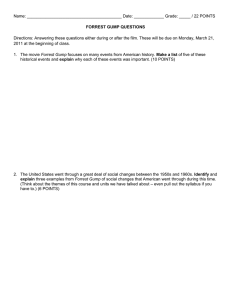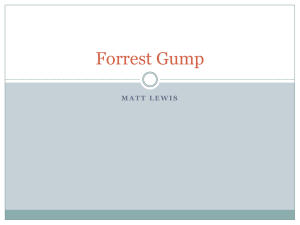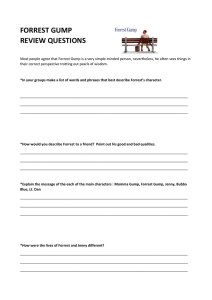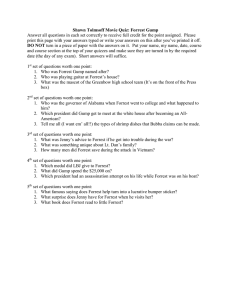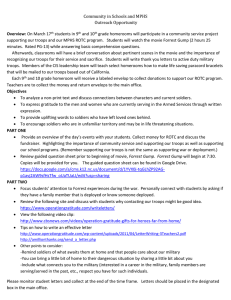Chicago
advertisement
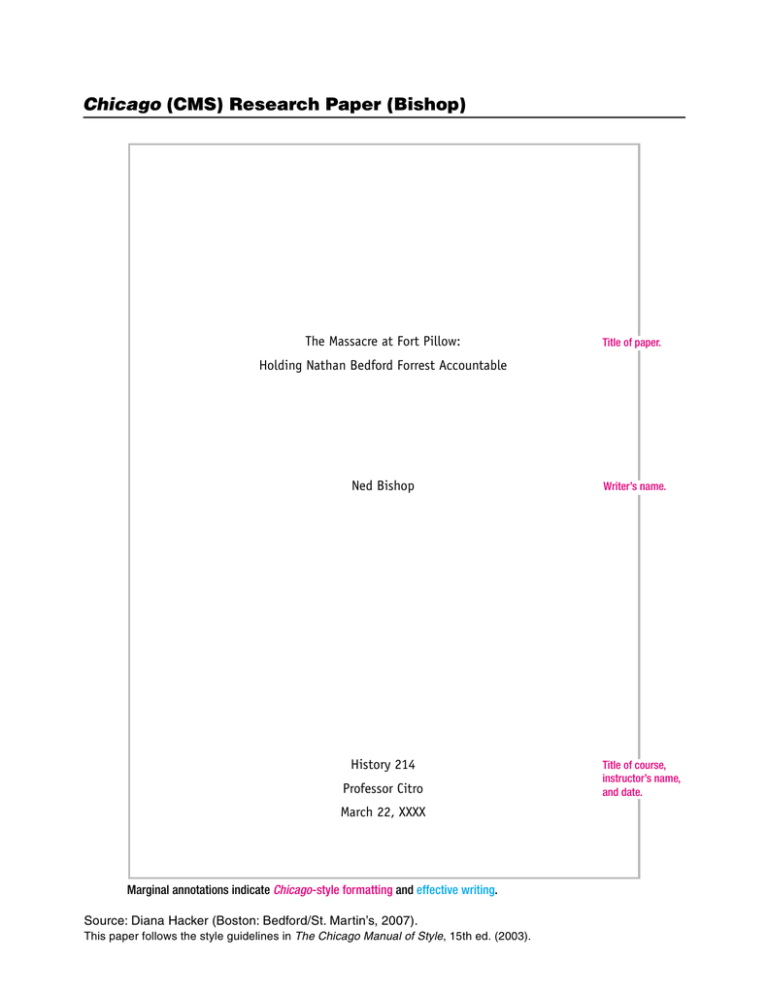
Chicago (CMS) Research Paper (Bishop) The Massacre at Fort Pillow: Title of paper. Holding Nathan Bedford Forrest Accountable Ned Bishop Writer’s name. History 214 Title of course, instructor’s name, and date. Professor Citro March 22, XXXX Marginal annotations indicate Chicago-style formatting and effective writing. Source: Diana Hacker (Boston: Bedford/St. Martin’s, 2007). This paper follows the style guidelines in The Chicago Manual of Style, 15th ed. (2003). Bishop 2 Although Northern newspapers of the time no doubt exaggerated some of the Confederate atrocities at Fort Pillow, most modern sources agree that a massacre of Union troops took place there on April 12, 1864. It seems clear that Union soldiers, particularly black soldiers, were killed after they had stopped fighting or had surrendered or were being held prisoner. Less clear is the role played by Major General Nathan Bedford Forrest in leading his Thesis asserts writer’s main point. troops. Although we will never know whether Forrest directly ordered the massacre, evidence suggests that he was responsible for it. Headings help readers follow the organization. What happened at Fort Pillow? Fort Pillow, Tennessee, which sat on a bluff overlooking the Mississippi River, had been held by the Union for two years. It was garrisoned by 580 men, 292 of them from United States Colored Heavy and Light Artillery regiments, 285 from the white Thirteenth Statistics are cited with an endnote. Tennessee Cavalry. Nathan Bedford Forrest commanded about 1,500 men.1 The Confederates attacked Fort Pillow on April 12, 1864, and had virtually surrounded the fort by the time Forrest arrived on the battlefield. At 3:30 p.m., Forrest demanded the surrender of the Union forces, sending in a message of the sort he had used before: “The conduct of the officers and men garrisoning Fort Pillow has been such as to entitle them to being treated as prisoners Quotation is cited with an endnote. of war. . . . Should my demand be refused, I cannot be responsible for the fate of your command.”2 Union Major William Bradford, who had replaced Major Booth, killed earlier by sharpshooters, Source: Diana Hacker (Boston: Bedford/St. Martin’s, 2007). Bishop 3 asked for an hour to consider the demand. Forrest, worried that vessels in the river were bringing in more troops, “shortened the time to twenty minutes.”3 Bradford refused to surrender, and Forrest quickly ordered the attack. The Confederates charged to the fort, scaled the parapet, and fired on the forces within. Victory came quickly, with the Union forces running toward the river or surrendering. Shelby Foote describes the scene like this: Some kept going, right on into the river, where a number drowned and the swimmers became targets for marksmen on the bluff. Others, dropping their guns in terror, ran back Long quotation is set off from text by indenting. Quotation marks are omitted. toward the Confederates with their hands up, and of these some were spared as prisoners, while others were shot down in the act of surrender.4 In his own official report, Forrest makes no mention of the massacre. He does make much of the fact that the Union flag was not lowered by the Union forces, saying that if his own men had not taken down the flag, “few, if any, would have survived unhurt another volley.”5 However, as Jack Hurst points out and Forrest must have known, in this twenty-minute battle, “Federals running for their lives had little time to concern themselves with a flag.”6 The federal congressional report on Fort Pillow, which charged the Confederates with appalling atrocities, was strongly criticized by Southerners. Respected writer Shelby Foote, while agreeing that the report was “largely” fabrication, points out that the “casualty figures . . . indicated strongly that unnecessary Source: Diana Hacker (Boston: Bedford/St. Martin’s, 2007). Writer uses a primary source as well as secondary sources. Quotation is introduced with a signal phrase. Bishop 4 The writer draws attention to an important article containing primary sources. killing had occurred.”7 In an important article, John Cimprich and Robert C. Mainfort Jr. argue that the most trustworthy evidence is that written within about ten days of the battle, before word of the congressional hearings circulated and Southerners realized the extent of Northern outrage. The article reprints a group of letters and newspaper sources written before April 22 and thus “untainted by the political overtones the controversy later assumed.”8 Cimprich and Mainfort conclude that these sources “support the case for the occurrence of a massacre” but that Forrest’s role remains “clouded” because of inconsistencies in testimony.9 Did Forrest order the massacre? Topic sentence states the main idea for this section. We will never really know whether Forrest directly ordered the massacre, but it seems unlikely. True, Confederate soldier Achilles Clark, who had no reason to lie, wrote to his sisters that “I with several others tried to stop the butchery . . . but Gen. Writer presents a balanced view of the evidence. Forrest ordered them [Negro and white Union troops] shot down like dogs[,] and the carnage continued.”10 But it is not clear whether Clark heard Forrest giving the orders or was just reporting hearsay. Many Confederates had been shouting “No quarter! No quarter!” and, as Shelby Foote points out, these shouts were “thought by some to be at Forrest’s command.”11 A Union soldier, Jacob Thompson, claimed to have seen Forrest order the killing, but when asked to describe the six-foot-two general, he called him “a little bit of a man.”12 Perhaps the most convincing evidence that Forrest did not order the massacre is that he tried to stop it once it had begun. Source: Diana Hacker (Boston: Bedford/St. Martin’s, 2007). Bishop 5 Historian Albert Castel quotes several eyewitnesses on both the Union and Confederate sides as saying that Forrest ordered his men to stop firing.13 In a letter to his wife three days after the battle, Confederate soldier Samuel Caldwell wrote that “if General Forrest had not run between our men & the Yanks with his pistol and sabre drawn not a man would have been spared.”14 In a respected biography of Nathan Bedford Forrest, Hurst suggests that the temperamental Forrest “may have ragingly ordered a massacre and even intended to carry it out--until he rode inside the fort and viewed the horrifying result” and ordered it stopped.15 While this is an intriguing interpretation of events, even Hurst would probably admit that it is merely speculation. Can Forrest be held responsible for the massacre? Even assuming that Forrest did not order the massacre, he can still be held accountable for it. That is because he created an atmosphere ripe for the possibility of atrocities and did nothing to ensure that it wouldn’t happen. Throughout his career Forrest repeatedly threatened “no quarter,” particularly with respect to black soldiers, so Confederate troops had good reason to think that in massacring the enemy they were carrying out his orders. As Hurst writes, “About all he had to do to produce a massacre was issue no order against one.”16 Dudley Taylor Cornish agrees: It has been asserted again and again that Forrest did not order a massacre. He did not need to. He had sought to terrify the Fort Pillow garrison by a threat of no quarter, as he had done at Union City and at Paducah in the days just before Source: Diana Hacker (Boston: Bedford/St. Martin’s, 2007). Topic sentence for this section echoes the thesis. Bishop 6 he turned on Pillow. If his men did enter the fort shouting “Give them no quarter; kill them; kill them; it is General Forrest’s orders,” he should not have been surprised.17 The slaughter at Fort Pillow was no doubt driven in large part by racial hatred. Numbers alone suggest this: Of 295 white troops, 168 were taken prisoner, but of 262 black troops, only 58 were taken into custody, with the rest either dead or too badly wounded to walk.18 A Southern reporter traveling with Forrest makes clear that the discrimination was deliberate: “Our troops maddened by the excitement, shot down the ret[r]eating Yankees, and not until they had attained t[h]e water’s edge and turned to beg for mercy, did any prisoners fall in [t]o our hands--Thus the whites received quarter, but the negroes were shown no mercy.”19 Union surgeon Dr. Charles Fitch, who was taken prisoner by Forrest, testified that after he was in custody he “saw” Confederate soldiers “kill every negro that made his appearance dressed in Federal uniform.”20 Transition sentence links new material to old. Fort Pillow is not the only instance of a massacre or threatened massacre of black soldiers by troops under Forrest’s command. Biographer Brian Steel Wills points out that at Brice’s Cross Roads in June 1864, “black soldiers suffered inordinately” as Forrest looked the other way and Confederate soldiers deliberately sought out those they termed “the damned negroes.”21 Just a day after Fort Pillow, on April 13, 1864, one of Forrest’s generals, Abraham Buford, after consulting with Forrest, demanded that the federal garrison in Columbus, Kentucky, surrender. The demand stated that if an attack became Source: Diana Hacker (Boston: Bedford/St. Martin’s, 2007). Bishop 7 necessary, “no quarter will be shown to the negro troops whatever; the white troops will be treated as prisoners of war.”22 Nathan Bedford Forrest, a crude man who had made his fortune as a slave trader, was noted for both his violence and his hatred of blacks. In the words of historian James M. McPherson, “Forrest possessed a killer instinct toward . . . blacks in any capacity other than slave.”23 Forrest’s battle successes were largely due to his brazen tactics--tactics that Hurst says would not have occurred Ellipsis mark indicates that words have been omitted. to the “aristocratic, well-educated Confederate military hierarchy.”24 Some Southerners, in fact, found Forrest’s leadership style distasteful. As one Mississippi aristocrat put it, “Forrest may be, and no doubt is, the best cavalry officer in the West, but I object to a tyrrannical [sic], hot-headed vulgarian’s commanding me.”25 Because he was so crudely racist, Forrest surely understood the rage that his troops felt toward the very idea of blacks as soldiers. Further, he must have known that his standard threats of “No quarter” would fuel the Confederate soldiers’ rage. Although Forrest may have tried to prevent the massacre once it was under way, he can still be held accountable for it. That is because he created the conditions that led to the massacre (especially of black troops) and with full knowledge of those conditions took no steps to prevent what was a nearly inevitable bloodbath. Source: Diana Hacker (Boston: Bedford/St. Martin’s, 2007). Conclusion echoes the writer’s central argument. Bishop 8 Notes First line of each note is indented 1⁄ 2'' (or 5 spaces). 1. John Cimprich and Robert C. Mainfort Jr., eds., “Fort Pillow Revisited: New Evidence about an Old Controversy,” Civil War History 28, no. 4 (1982): 293-94. Note number is not raised and is followed by a period. 2. Quoted in Brian Steel Wills, A Battle from the Start: The Life of Nathan Bedford Forrest (New York: HarperCollins, 1992), 182. 3. Ibid., 183. 4. Shelby Foote, The Civil War, a Narrative: Red River to Appomattox (New York: Vintage, 1986), 110. Authors’ names are not inverted. 5. Nathan Bedford Forrest, “Report of Maj. Gen. Nathan B. Forrest, C. S. Army, Commanding Cavalry, of the Capture of Fort Pillow,” Shotgun’s Home of the American Civil War, http:// www.civilwarhome.com/forrest.htm. 6. Jack Hurst, Nathan Bedford Forrest: A Biography (New York: Knopf, 1993), 174. Last name and title refer to an earlier note by the same author. 7. Foote, Civil War, 111. 8. Cimprich and Mainfort, “Fort Pillow,” 295. 9. Ibid., 305. 10. Ibid., 299. 11. Foote, Civil War, 110. Bishop cites an indirect source: words quoted in another source. Notes are singlespaced, with double-spacing between notes. (Some instructors may prefer double-spacing throughout.) 12. Quoted in Wills, Battle from the Start, 187. 13. Albert Castel, “The Fort Pillow Massacre: A Fresh Examination of the Evidence,” Civil War History 4, no. 1 (1958): 44-45. 14. Cimprich and Mainfort, “Fort Pillow,” 300. 15. Hurst, Nathan Bedford Forrest, 177. 16. Ibid. Source: Diana Hacker (Boston: Bedford/St. Martin’s, 2007). Bishop 9 17. Dudley Taylor Cornish, The Sable Arm: Black Troops in the Union Army, 1861-1865 (Lawrence, KS: University Press of Kansas, 1987), 175. 18. Foote, Civil War, 111. 19. Cimprich and Mainfort, “Fort Pillow,” 304. 20. Quoted in Wills, Battle from the Start, 189. 21. Ibid., 215. 22. Quoted in Hurst, Nathan Bedford Forrest, 177. 23. Quoted in James M. McPherson, Battle Cry of Freedom: The Civil War Era (New York: Oxford University Press, 1988), 402. 24. Hurst, Nathan Bedford Forrest, 74. 25. Quoted in Foote, Civil War, 106. Source: Diana Hacker (Boston: Bedford/St. Martin’s, 2007). Bishop 10 Bibliography Entries are alphabetized by authors’ last names. Castel, Albert. “The Fort Pillow Massacre: A Fresh Examination of the Evidence.” Civil War History 4, no. 1 (1958): 37-50. Cimprich, John, and Robert C. Mainfort Jr., eds. “Fort Pillow Revisited: New Evidence about an Old Controversy.” Civil War History 28, no. 4 (1982): 293-306. First line of entry is at left margin; additional lines are indented 1⁄ 2'' (or 5 spaces). Cornish, Dudley Taylor. The Sable Arm: Black Troops in the Union Army, 1861-1865. Lawrence, KS: University Press of Kansas, 1987. Foote, Shelby. The Civil War, a Narrative: Red River to Appomattox. New York: Vintage, 1986. Forrest, Nathan Bedford. “Report of Maj. Gen. Nathan B. Forrest, C. S. Army, Commanding Cavalry, of the Capture of Fort Pillow.” Shotgun’s Home of the American Civil War. http:// www.civilwarhome.com/forrest.htm. Entries are singlespaced, with double-spacing between entries. (Some instructors may prefer doublespacing throughout.) Hurst, Jack. Nathan Bedford Forrest: A Biography. New York: Knopf, 1993. McPherson, James M. Battle Cry of Freedom: The Civil War Era. New York: Oxford University Press, 1988. Wills, Brian Steel. A Battle from the Start: The Life of Nathan Bedford Forrest. New York: HarperCollins, 1992. Source: Diana Hacker (Boston: Bedford/St. Martin’s, 2007).
